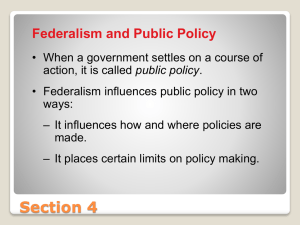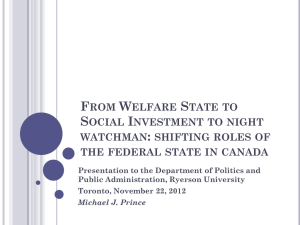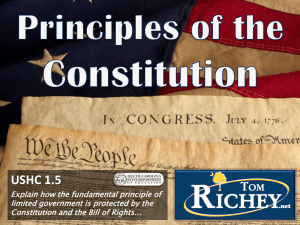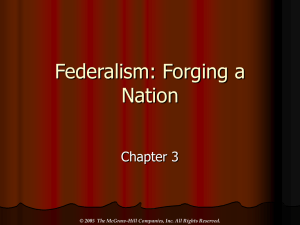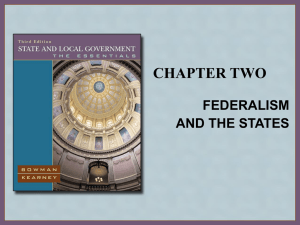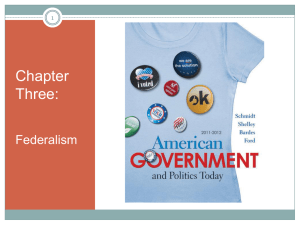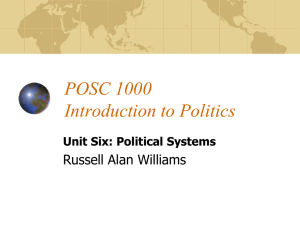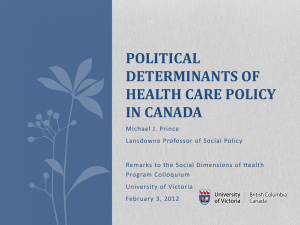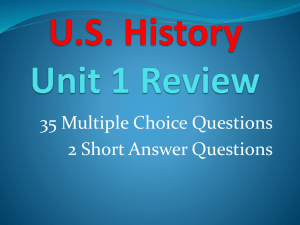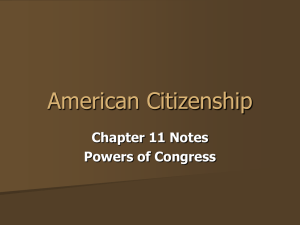AP-Ch.3-Federalism-2014 - Saint Bonaventure High School
advertisement
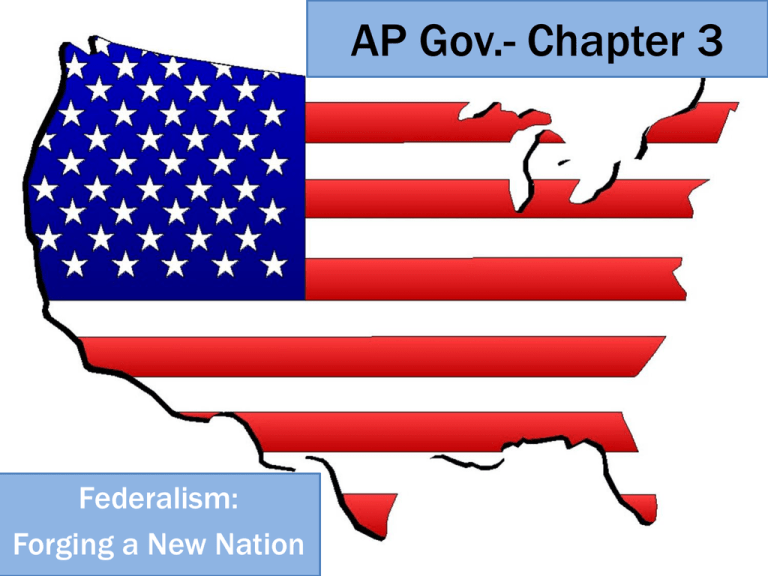
AP Gov.- Chapter 3 Federalism: Forging a New Nation Federalism: National and State Sovereignty • Sovereignty: – Ultimate governing authority – Can be divided between different levels of governments. • Federalism – United States, Canada • Confederacy – U.S. under the Articles of Confederation • Unitary System – France, Japan, Sweeden – (Modified) Great Britain, Mexico, Italy Confederacy National Government NO Sovereignty State Government ALL Sovereignty Unitary System National Government ALL Sovereignty State Government NO Sovereignty Federalism National Government Some Sovereignty State Government Some Sovereignty Federalism: National and State Sovereignty • The Argument for Federalism – Federalism will: • • • • protect liberty force officials to be more responsive to the people provide for a stronger national government preserve the states as sovereign governments • James Madison- a large republic is less likely to have an allpowerful faction Federalist No. 10 • The Framers invented federalism – The states already existed Federalism: National and State Sovereignty • Antifederalists – Patrick Henry opposed the ratification of the Constitution – Antifederalists thought that: • state-centered government would do a better job protecting the diversity of interests among the people • too strong of a national government meant eventual encroachment upon the sovereignty of the states Federalism: National and State Sovereignty • The Powers of the Nation – Enumerated Powers • Article I- defines the lawful powers of the national government • Article I- Section 8- “Congress shall have the power too…” – – – – Lay and collect taxes Declare war Coin money Regulate interstate and foreign trade (Commerce Clause) • Article VI- Supremacy Clause – Implied Powers • Article I Section 8- Elastic Clause “To make all laws which shall be necessary and proper for carrying into execution the forgoing powers, and all other powers vested by this Constitution…” Federalism: National and State Sovereignty • Commerce Clause – Congress regulates foreign and interstate trade • State Powers (reserved powers) – Regulate intrastate trade – Establish schools – Regulate marriage – Provide for law and order Federalism: National and State Sovereignty • The Powers of the States – Reserved Powers • 10th Amendment- addressed the concerns of the Antifederalists about the powers of the state governments – “The powers not delegated to the United States by the Constitution, nor prohibited by it to the States, are reserved to the States respectively, or to the people.” Federalism in Historical Perspective • An Indestructible Union (1789-1865) – The Nationalist View: • McCulloch v. Maryland – Under the doctrine of implied powers, » Congress had the power to create a national bank because it was assigned the powers to tax, borrow money, and regulate interstate commerce under the Constitution, » Affirmed that national law is supreme to conflicting state law • Article VI- “Supremacy Clause” – The States’-Rights View: • The Dred Scott Decision – Dred Scott was property, and therefore ineligible to sue in the federal courts. – struck down the Missouri Compromise of 1820 as unconstitutional. – intensified the conflict between the North and South. • Civil War – John C. Calhoun- “government of states…not a government of people” – Lincoln- “The Union is older than the states” Federalism in Historical Perspective • Dual Federalism and Laissez-Faire Capitalism (1865-1937) – Dual Federalism- separation of state and national authority • Sup. Court- “The power which one posses, the other does not” • “Layer-Cake” theory • Characterized by state supremacy in racial policy and business supremacy in commerce policy – A high wall of separation of gov. and economy – The Fourteenth Amendment and State Discretion • Plessy v Ferguson (1896)- “Separate but equal” Federalism in Historical Perspective • Dual Federalism and Laissez-Faire Capitalism (18651937) (cont.) – Judicial Protection of Business • The commerce clause only applied to “transportation” of goods not their “manufacture” • 1886- Corporations are “persons” under the 14th Amendment • Hammer v. Dagenhart (1918)- 10th Amendment gave the states, not the federal government, the power to regulate factory practices • Schecter Poultry Corp. v. United States (1935)- declared FDR’s National Industry Recovery Act unconstitutional • FDR’s court-packing plan fails – Justice Owen Roberts later switched to FDR’s side on New Deal cases – National Authority Prevails • Great Depression- the national government asserted the power to regulate the nation’s economy – As high as 25% unemployment at depths of depression • Government was the only counter force strong enough to control business trusts of the late 19th and early 20th centuries Federalism in Historical Perspective • Toward National Citizenship – Brown v Board of Education, Topeka, Kansas (1954)- states could not force black children to attend schools separate from those for white children – Miranda v Arizona – National authority has expanded in the 20th century primarily because the state and their citizens have become increasingly interdependent Contemporary Federalism (since 1937) • Interdependency and Intergovernmental Relations – Cooperative Federalism- a blending of state and national authority • Jointly funded • Jointly administered • Jointly determined – Medicaid is an example of cooperative federalism • “Marble Cake” theory of federalism – States still retain many areas of traditional authority • Education- primarily the function of state and local government – Nearly 95 % of the funding for U.S. public schools comes from the states and localities American Federalism Marble Cake or Layer Cake? Marble Cake Federalism based on pragmatic mixing of authority and programs among the national, state, and local governments. Layer Cake Federalism based on a clear delineation of authority and programs among the levels of government. Contemporary Federalism (since 1937) • Government Revenues and Intergovernmental Relations – Fiscal Federalism • Grants-in-aid – If a state accepts a grant-in-aid, it must comply with federal restrictions on its use – Categorical and Block Grants • Categorical Grants- specific purpose • Block Grants- less restrictive, more general Contemporary Federalism (since 1937) • A New Federalism: Devolution – Devolution- the passing of authority from the national government to the state and local governments • Nixon & Reagan proposed versions of a “new federalism” that would give more control to the states and localities – Budgetary Pressures and Public Opinion – The Republican Revolution-Newt Gingrich- Speaker of the House • Unfunded Mandates Reform Act of 1995 – Ended some federal programs that require action by states and localities without providing money to pay for it (exceptions included laws relating to civil rights) • Welfare Reform Act – Temporary Assistance for Needy Families (TNAF)- restricts a family’s eligibility for federal assistance to five years & after two years, a family head has to go to work Contemporary Federalism (since 1937) • A New Federalism: Devolution – Devolution, Judicial Style • Printz v. United States (1997) – struck down a provision of the Handgun Violence Prevention Act (Brady Bill) – Violated the 10th Amendment because it forced state employees to “enforce a federal regulatory program.” • Kimil v. Board of Regents (2000) – Age discrimination is not among the rights guaranteed under the constitution – Florida was not bound by federal law in deciding the age policies that apply to state employees • Board of Trustees of the University of Alabama v. Garrett (2002) – Similar ruling to “Kimil” in regards to a federal law banning discrimination against the disabled – These rulings only apply to state employees Contemporary Federalism (since 1937) • Nationalization, the More Powerful Force – No Child Left Behind • Bush argued that the U.S. needed an national education standard – Terrorist Attacks of 9/11/2001 • Department of Homeland Security – The Great Recession • Near collapse of the financial markets • $800 billion stimulus bill – Patient Protection & Affordable Care Act • “Obamacare” • Federal Mandate- everybody must have health insurance – Expansion of Medicaid – States must set up insurance “pools” – Private insurance reform
